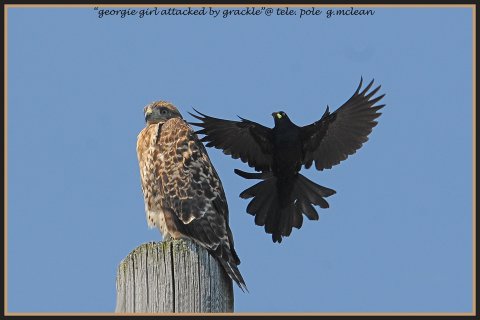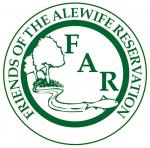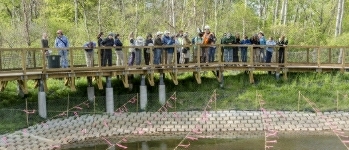Photo and story by Paul Roberts
It was a boring fall for Buzz and Belle. Following the unexplained nest failure in the old pine tree off Fawcett Street, Buzz hurriedly built a new nest on the "annex" on the atrium of 185 Alewife Brook Parkway. Buzz worked on it for over a week and often looked east as if seeking a positive response from his new mate. We had the feeling that he was looking to attract Belle to this new 185 nest and to copulate with her to generate a new clutch of eggs. However, that second full round of copulation did not appear to happen, no eggs were laid a second time,, and Belle was seen on 185 only in rare occasions.
Belle instead seemed to prefer perching high on the Radio Antenna south of Danehy, looking south and southwest. Early and late. Week after week. Buzz would frequently come and perch on the antenna not far from Belle, but rarely side by side. And usually not together for long period of time. This appeared to be Belle's territory, but not really Buzz's. She perched here much more frequently and for far longer than Buzz and Ruby had. This seemed to be Belle marking her territory, and showing very limited interest in Buzz's historic patrimony. Buzz spent more time in the vicinity of Danehy Park and the National Guard Armory than he had in the past, and Belle occasionally joined him there. But there was a very real question in my mind if this relationship was going to survive. The relationship seemed more like a couple going through separation than focused on building a family for the future. Buzz was occasionally seen west of Route 2, but not as frequently as he had in the past.
But gradually there seemed to be a change in attitudes. Buzz began spending more time west of Route 16; particularly in Fresh Pond Reservation and to a lesser extent on Social Security and Raytheon. He began perching more frequently again on 545. Gradually, Belle appeared to spend more time in Buzz's historic homeland, perching west of Lusitania, close to Neville Manor, and she began perching regularly (but not frequently) on Social Security and Raytheon. There was a change in attitude. Perhaps an acceptance of what Buzz had built up over more than a decade in the Fresh Pond Mall vicinity. They occasionally perched together on the roof of Raytheon, on the satellite dish. They spent more time in trees and less time on transmitters.
I had been looking for them to be working on a new nest. Quite possibly south of Danehy. Belle had clearly rejected the nest Buzz had built on 185 in the annex in June. There was little interest shown in remodeling the old nest Buzz and Ruby had shared in 2010-11 on the Atrium at 185. The nest they had attempted to use unsuccessfully off Fawcett Street, the pine that Buzz and Ruby had used for two years, did not appear to be a viable option. The tree had died, and it is possible that the new floor Buzz and Belle had laid over the eggs abandoned when Ruby died had collapsed.
With the winter solstice, days slowly begin to grow longer. There is more daylight, and the angle of sunlight intensifies. Many birds are intensely aware of this. The advent of winter means spring is only three months away. Buzz and Ruby had laid eggs in the first half of March. This means they have to be working on the nest in February, if not sooner. If they were hedging their real estate bets by working on another nest or two, they should be doing at least minimal maintenance on it now, showing it is occupied and reducing the work necessarily as they approached actual nesting. But we did not see concrete evidence that they were in fact working on another nest site or two. We checked around, but saw no evidence that they were working on another nest. There is the nest Ruby developed several years ago in the pine tree, but it is now much more difficult to observe and see if it is being visited or used. When we checked, there was no evidence that it was being used.
About a month ago, however, Buzz was seen perching on the atrium at 185, and then visiting the nest he had built in the annex. And then again. And then again. And then with Belle, and with Saturday's snowfall, both Buzz and Belle visited the nest on Sunday morning. Ahhh, the rays of sunlight are palpably more intense in late January than they had been at any time in December. Time is turning. It is now only six weeks from when apparently Ruby laid her first egg last year. Six weeks!!!! Belle needs to start eating better, and to have her mate provide more food to her. She needs to build herself up to power the desire to copulate and to laying up to 4 eggs that would actually constitute a significant percentage of her body weight. February is not a time of great abundance of food, so they need to be working together. And they need to agree on where Belle is comfortable nesting and raising kids. (We don't know if she has ever successfully raised young before, but she is old enough to have been mated with another male in her previous life.) In other words, though we are obviously descending into the depths of winter with an all-time top five snow-storm forecast for the next two days, we are drawing ever closer to a critical time for our Redtails. (They can nest later if they have to, but evidence suggests that pairs that nest earlier have an advantage and tend to be more successful, which is why they drive to nest earlier.)
The blizzard we are to have on January 26th-28th might alter their plans. Food appears to have been relatively easy to come by so far this winter. The absence of snow cover and ice means small rodents should be more available. More birds, such as pigeons and blackbirds, are around because their ground-based food sources are more available. Squirrel populations have made a significant comeback due to a good acorn crop in 2014. Fortunately, we have seen very little evidence of Buzz or Belle feeding on rats these past seven months, which would reduce their opportunities for ingesting rat poison. However 2+ feet of snow changes the equation. Forecasts of persistent cold means the snow cover will remain for a week or more, perhaps amplified by another snowstorm this weekend. Small rodents become less accessible. Some birds will be struggling to find food, so they will cluster more around feeders and be more vulnerable to predation, especially if they are weakened by cold or starvation. Squirrels may spend more time in their leaf nests or holes, relying on food stored there, but then they will start searching for buried acorns and seeds. There may be more pressure to take rats if the snow cover persists, and that increases the risk of poisoning.
We don't know Belle's age, though she is almost certainly in at least her fourth calendar year. Buzz is at least 15 years old, which is pretty old for a Red-tailed Hawk. That is a cause for concern. At the same time his experience is also an asset. (Pale Male for example, is much older than Buzz.) But the stress of coping with heavy snow, gale force winds, and reduced food supplies is a challenge for a hawk at any age.
Thus, it is worth glancing towards the nest on 185, on the right (north) side of the atrium to see if any hawk is there, or if there has been some obvious work done on the nest. Shopping at Whole Paycheck or TJ's, check out 185, and 545, and the tops of the Social Security an Raytheon buildings. Buzz and Belle ARE spending much more time in Buzz's old stomping grounds. You are much more likely to see them now than you have been for the past six months (especially if you weren't checking out the radio antenna.) You might see them spending more time together, possibly perched side by side. On sunny days you might see them soaring together. Look for signs of new or renewed bonding.
But Buzz and Belle also don't live in a bubble. Their projected nest on 185 Alewife Brook Parkway is roughly 800 feet from the winter residence of a pair of mated adult Peregrine Falcons. These birds know each other. They see each other daily. Both Peregrines have done "flybys" several times over the winter, passing close to the buteos to make a point, but we've not seen evidence of aggressive attacks to drive the Redtails away. The Peregrines have, in fact, seemed to behave similarly to Buzz and Belle. They were both roosting on the Fresh Pond towers, but they usually perched apart and on separate towers. They were together, and they were not. Occasionally they perched together, but only occasionally. He usually captures small prey within minutes of dawn. Not the case for Mrs. P. In fact, she occasionally flies over to Mr. P when he has prey, as in giving him the opportunity to share. Surprisingly, at least twice this fall/winter we have seen him take a pigeon. We've seen him chase pigeons many times, but catch them? No. Both times he had real difficulty carrying the dead prey up to the top of one of the towers. One time he gave up and landed much lower on another building. The pigeon was almost too big for the small male. His mate, however, is much larger and has no such problems. In fact, I once saw her capture a large pigeon when she already had a pigeon carcass in the other talons! She eventually lost or intentionally dropped the second bird, still alive, but she is literally a two-fisted hunter.
Historically, the hormones really start to surge in Buzz and his mate in February. The same holds true in the falcons. The "little ball of hate" (the juvenile male Peregrine several years ago) would irritate Buzz and Ruby throughout the fall and winter, but in February he became serious and attacked them. Whether it was just that he would not tolerate them hunting pigeons that he felt belonged to him, or that he felt they were too close to his wintering territory, he attacked them. He convinced them that they could not continue to nest on 185. I'll never forget the day he attacked both Buzz and Ruby, and her screams when he strafed her on the roof of 185. The pair of Peregrines does not breed on Fresh Pond Towers. They have bred on the Tufts Health Care building in Watertown, and we believe on Memorial Hall at Harvard. Last year they, too, were unsuccessful with apparently two clutches, just like Buzz. Soon they should be spending more and more time at the site they plan to nest at this year. But when those territorial juices start surging, they might not be inclined to tolerate the presence of nesting Redtails so close to their still base of operations. They might become very demonstrative. They might not let Buzz and his "new" mate nest on 185. But then, again, they might. Time – and observation – will tell.
The storm we are in the middle of tonight may actually be the calm before the storm. Will both pairs survive this blizzard intact? Buzz has been through the single biggest blizzard in Boston's history. Can he and his mate do it again? The Peregrines look to have better odds in terms of the availability of food. Over the next several months time will tell. The story will unfold, and unlike the past three years, people frequenting the Fresh Pond Mall area will have a chance to see how it unfolds. Keep your eyes open, and please report what you see on 185Redtails or ArlingtonBirds.
Last week I stopped in McDonald's in the mall for a cup of hot coffee on a cold day. An elderly looking but very friendly gentleman (probably younger than me) got some food and walked out the door with me. I was wearing my binos and my megazoom camera just in case I saw anything. (I actually had just taken the best photos of the Peregrines I've taken all winter, perched 22 stories above.) As we walked out he pointed out the nest on the annex and told me that three or four years ago there was a beautiful pair of hawks that nested on that building and raised several kids there.
I don't think that I had ever seen him before, and certainly not talked with him before. But he had seen Buzz and Ruby raise their kids, even without binoculars or camera, and he appreciated it. He said it had been really incredible. I agreed. It really had been incredible. And there is the possibility, a distinct wisp of a possibility, that we might have a chance at seeing something incredible like that again.
Keep warm and safe,
Paul
 Georgie attacked
Georgie attacked- Home
- Directions
- FAR Wildlife Blog
- Calendar
- News
- Donate Now
- Get Social!
- Storm Water Wetlands
- Plants and Restoration
- Photos
- Videos
- About & Projects
- Master Plan for Alewife
- Archive
- Newsletters
- Contact
 Presentation Spotlighting Alewife Reservation
Presentation Spotlighting Alewife Reservation
 Follow us on Twitter
Follow us on Twitter
 Like us on Facebook
Like us on Facebook
 Follow us on Instagram
Follow us on Instagram
Forward our web address to a friend!
- An Urban Gem - Alewife Reservation Nature Preserve
- Envisioning The Silver Maple Forest
- History and Policies of Cambridge, Belmont, and DEP
- Storm Water Wetlands
- Friends of Alewife Reservation brochure
(front, back) - Technical Analysis of Upper Alewife Basin
- Watershed: An Excursion in Four Parts
- The River Is A Restless Spirit: Life in the floodplain forest
-
Assessment of Silver Maple forest for DEP Adjudicatory hearings and
Patrick Fairbairn, author of the Assessment - Community Native Garden Flora
The
Alewife Reservation
is a unique natural resource for the communities of Belmont, Arlington and Cambridge
and home to hundreds of species, including hawks, coyotes beavers, snapping turtles, wild turkeys and muskrats,
the reservation is a unique natural resource for the community.
Historical information (Powerpoint)
Friends of Alewife Reservation works to protect and restore this wild area and the surrounding area for the water quality, native plants, animals and over 90 bird species with paths for walking, running and biking, recreation, and for classroom education and research. We regularly steward and preserve the Reservation area for wildlife and for the enjoyment of present and future generations.

(video)
By-Laws
About Friends of Alewife Reservation
Statement of Purpose
Citizen Forester newsletter archive
The Birds of the Cambridge Region of Massachusetts

by William Brewster 1906
Nuttal Ornithological Society
Biodiversity Study of Alewife Reservation Area: Species, Habitat, Ecosystems

Inventories by David Brown, wildlife assessor (2003, 2004.) Published by and available from FAR for $10. Write or call for your copy. (sample)
Updated Dave Brown Inventories (2008, 2010)
Inventories of Alewife Reservation Wetland Plants by Walter Kittredge, Botanist (2013)

